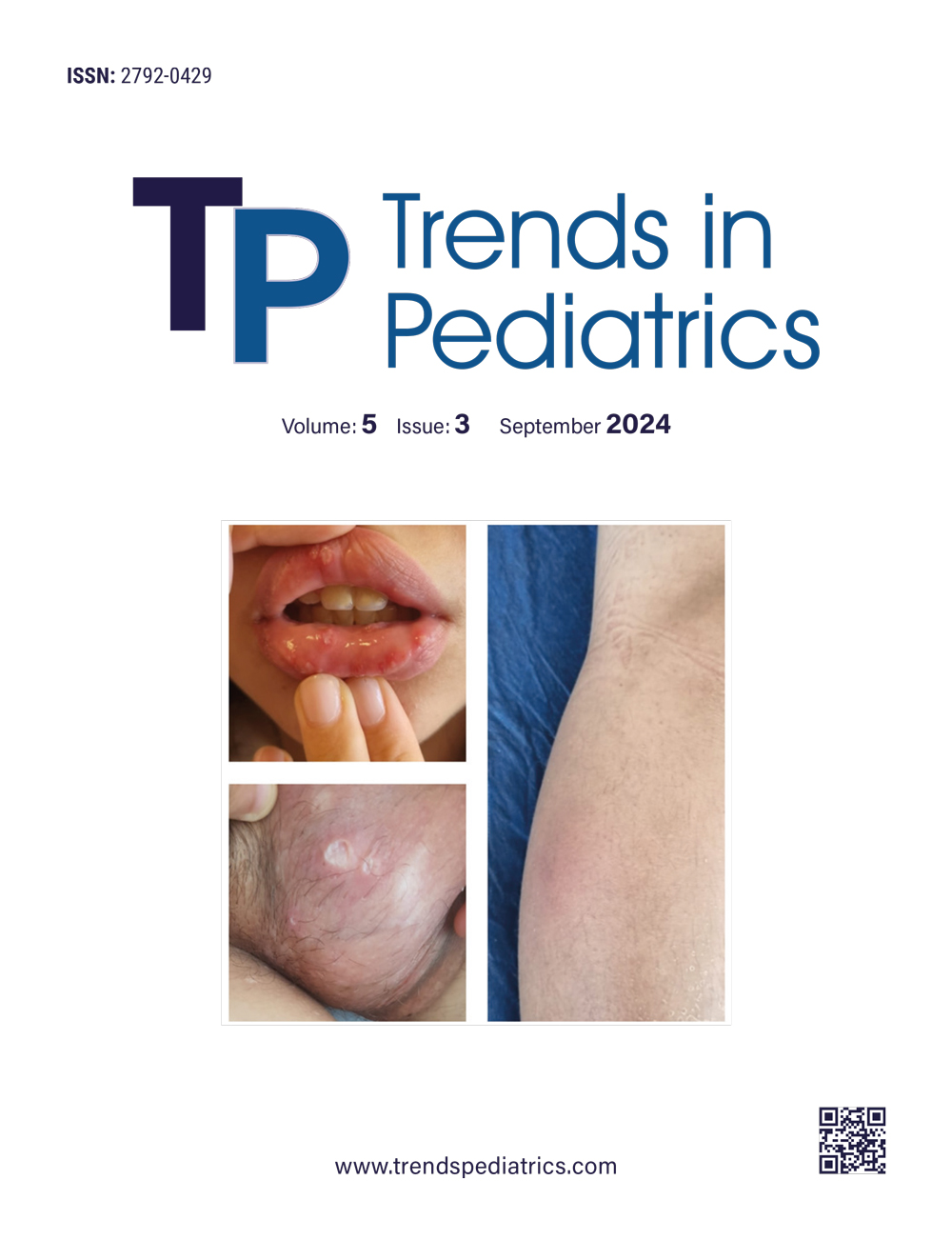Abstract
Objective: Patients with Noonan syndrome (NS), who may need various surgical interventions throughout their lives, need to be evaluated carefully in the preoperative period due to the risk of bleeding diathesis. There is a limited number of studies evaluating bleeding diathesis in patients with NS. In this study, we aimed to determine the frequency of bleeding diathesis in patients with NS and to evaluate the place of thromboelastography (TEG) in determining the risk of bleeding.
Method: In our study, bleeding score and coagulation test results obtained from the files of 12 patients with NS were evaluated.
Results: The most frequently detected factor deficiency is vWF deficiency (41%), followed by platelet dysfunction (33%). Two cases with a bleeding score of 2 or above were detected, and in one of them, both platelet dysfunction (response to epinephrine in platelet aggregometer, 7%) and vWF deficiency (vWF Ag: 20%), and in the other case, mild Factor VII deficiency (17%) were detected. TEG results of nine patients were normal. TEG abnormality was detected in three patients and 2 of them had bleeding phenotype.
Conclusion: As a result, although laboratory examinations in patients with NS often yield values consistent with bleeding diathesis, bleeding event does not occur in most patients. We suggest that with the use of the TEG method, the risk of bleeding can be predicted and unnecessary treatments can be prevented.
Keywords: bleeding disorders, laboratory test abnormalities, Noonan syndrome, thromboelastography
References
- Romano AA, Allanson JE, Dahlgren J, et al. Noonan syndrome: clinical features, diagnosis, and management guidelines. Pediatrics. 2010;126:746-59. https://doi.org/10.1542/peds.2009-3207
- Zenker M, Edouard T, Blair JC, Cappa M. Noonan syndrome: improving recognition and diagnosis. Arch Dis Child. 2022;107:1073-8. https://doi.org/10.1136/archdischild-2021-322858
- Nugent DJ, Romano AA, Sabharwal S, Cooper DL. Evaluation of bleeding disorders in patients with Noonan syndrome: a systematic review. J Blood Med. 2018;9:185-92. https://doi.org/10.2147/JBM.S164474
- Artoni A, Selicorni A, Passamonti SM, et al. Hemostatic abnormalities in Noonan syndrome. Pediatrics. 2014;133:e1299-304. https://doi.org/10.1542/peds.2013-3251
- Lan J, Zeng T, Liu S, Lan J, Qian L. Noonan syndrome with RAF1 gene mutations in a newborn with cerebral haemorrhage. Eur J Med Res. 2022;27:146. https://doi.org/10.1186/s40001-022-00772-2
- Linglart L, Gelb BD. Congenital heart defects in Noonan syndrome: Diagnosis, management, and treatment. Am J Med Genet C Semin Med Genet. 2020;184:73-80. https://doi.org/10.1002/ajmg.c.31765
- Turner AM. Noonan syndrome. J Paediatr Child Health. 2014;50:E14-20. https://doi.org/10.1111/j.1440-1754.2010.01970.x
- Derbent M, Öncel Y, Tokel K, et al. Clinical and hematologic findings in Noonan syndrome patients with PTPN11 gene mutations. Am J Med Genet A. 2010;152A:2768-74. https://doi.org/10.1002/ajmg.a.33713
- Noonan JA. Hypertelorism with Turner phenotype. A new syndrome with associated congenital heart disease. Am J Dis Child. 1968;116:373-80. https://doi.org/10.1001/archpedi.1968.02100020377005
- Witt DR, McGillivray BC, Allanson JE, et al. Bleeding diathesis in Noonan syndrome: a common association. Am J Med Genet. 1988;31:305-17. https://doi.org/10.1002/ajmg.1320310208
- Stoffman JM, Mcnicol A, Zelinski T, Chodirker BN, Israels SJ. The association between SHP-2 mutations and platelet function in Noonan syndrome. Blood 2008;112:1239 https://doi.org/10.1182/blood.V112.11.1239.1239
- Perez Botero J, Ho TP, Rodriguez V, Khan SP, Pruthi RK, Patnaik MM. Coagulation abnormalities and haemostatic surgical outcomes in 142 patients with Noonan syndrome. Haemophilia. 2017;23:e237-40. https://doi.org/10.1111/hae.13225
- Morice A, Harroche A, Cairet P, Khonsari RH. Preoperative detailed coagulation tests are required in patients with Noonan syndrome. J Oral Maxillofac Surg. 2018;76:1553-8. https://doi.org/10.1016/j.joms.2017.12.012
- van der Burgt I. Noonan syndrome. Orphanet J Rare Dis. 2007;2:4. https://doi.org/10.1186/1750-1172-2-4
- Bowman M, Mundell G, Grabell J, et al. Generation and validation of the Condensed MCMDM-1VWD Bleeding Questionnaire for von Willebrand disease. J Thromb Haemost. 2008;6:2062-6. https://doi.org/10.1111/j.1538-7836.2008.03182.x
- Toulon P, Berruyer M, Brionne-François M, et al. Age dependency for coagulation parameters in paediatric populations. Results of a multicentre study aimed at defining the age-specific reference ranges. Thromb Haemost. 2016;116:9-16. https://doi.org/10.1160/TH15-12-0964
- Favaloro EJ. Utility of the PFA-100 for assessing bleeding disorders and monitoring therapy: a review of analytical variables, benefits and limitations. Haemophilia. 2001;7:170-9. https://doi.org/10.1046/j.1365-2516.2001.00486.x
- Ng C, Motto DG, Di Paola J. Diagnostic approach to von Willebrand disease. Blood. 2015;125:2029-37. https://doi.org/10.1182/blood-2014-08-528398
- Saeveraas SB, Seghatchian J, Sivertsen J, Hervig T. The use of thromboelastography (TEG) in massively bleeding patients at Haukeland University Hospital 2008-15. Transfus Apher Sci. 2019;58:117-21. https://doi.org/10.1016/j.transci.2018.12.017
- Hartert H. Blood clotting studies with Thrombus stressography; a new investigation procedure. Klin Wochenschr. 1948;26:577-83. https://doi.org/10.1007/BF01697545
- Hans GA, Besser MW. The place of viscoelastic testing in clinical practice. Br J Haematol. 2016;173:37-48. https://doi.org/10.1111/bjh.13930
- Bruno L, Lenberg J, Le D, Dimmock D, Thornburg CD, Briggs B. Novel approach to improve the identification of the bleeding phenotype in Noonan syndrome and related RASopathies. J Pediatr. 2023;257:113323. https://doi.org/10.1016/j.jpeds.2022.12.036
- Barg AA, Yeshayahu Y, Avishai E, et al. Bleeding phenotype and hemostatic evaluation by thrombin generation in children with Noonan syndrome: a prospective study. Pediatr Blood Cancer. 2024;71:e30761. https://doi.org/10.1002/pbc.30761
- Bertola DR, Carneiro JD, D'Amico EA, et al. Hematological findings in Noonan syndrome. Rev Hosp Clin Fac Med Sao Paulo. 2003;58:5-8. https://doi.org/10.1590/s0041-87812003000100002
- Sharland M, Patton MA, Talbot S, Chitolie A, Bevan DH. Coagulation-factor deficiencies and abnormal bleeding in Noonan's syndrome. Lancet. 1992;339:19-21. https://doi.org/10.1016/0140-6736(92)90141-o
- Ruiz-Llobet A, Isola I, Gassiot S, et al. Platelet dysfunction in Noonan and 22q11.2 Deletion syndromes in childhood. Thromb Haemost. 2020;120:457-65. https://doi.org/10.1055/s-0040-1701239
Copyright and license
Copyright © 2024 The author(s). This is an open-access article published by Aydın Pediatric Society under the terms of the Creative Commons Attribution License (CC BY) which permits unrestricted use, distribution, and reproduction in any medium or format, provided the original work is properly cited.














